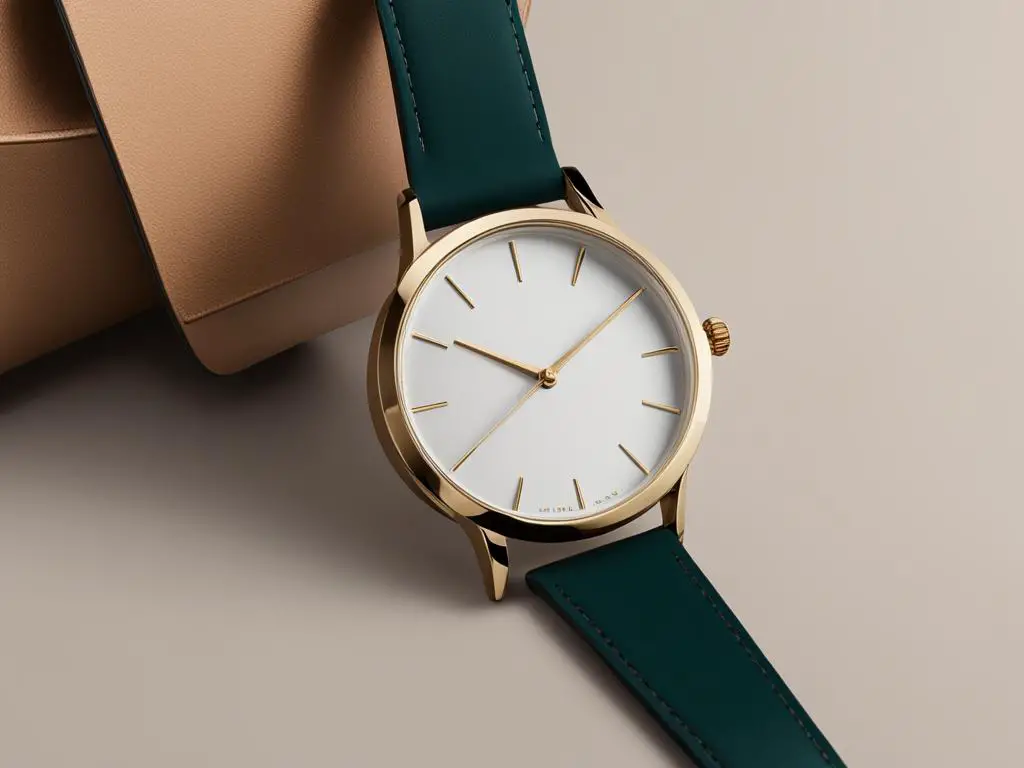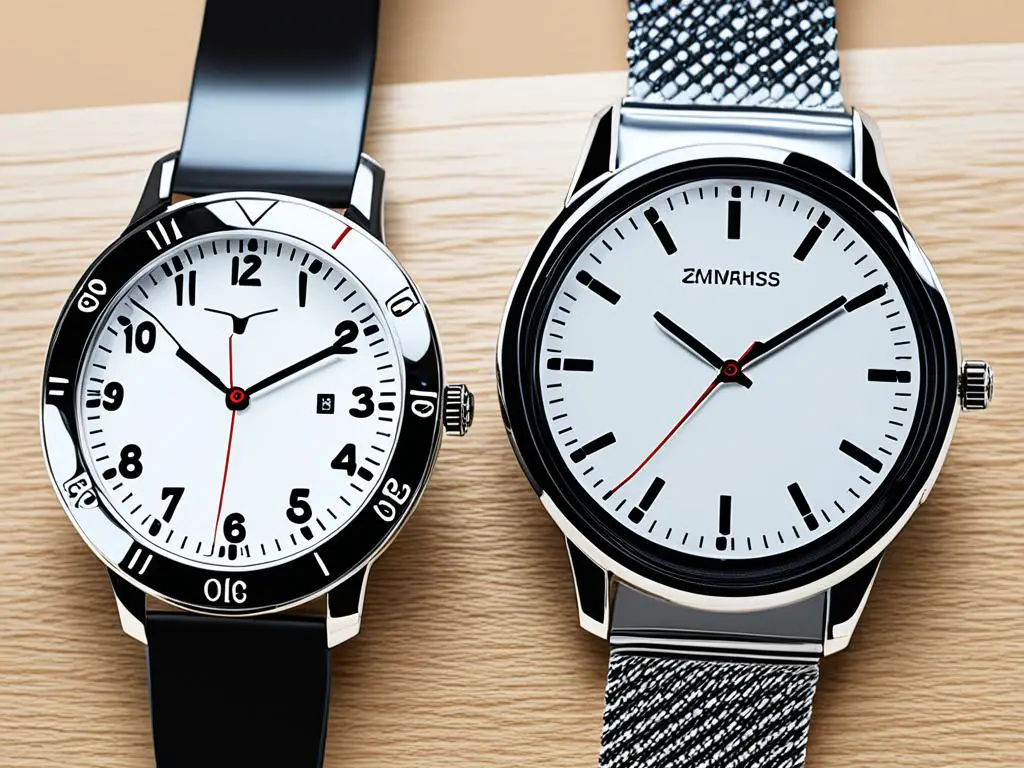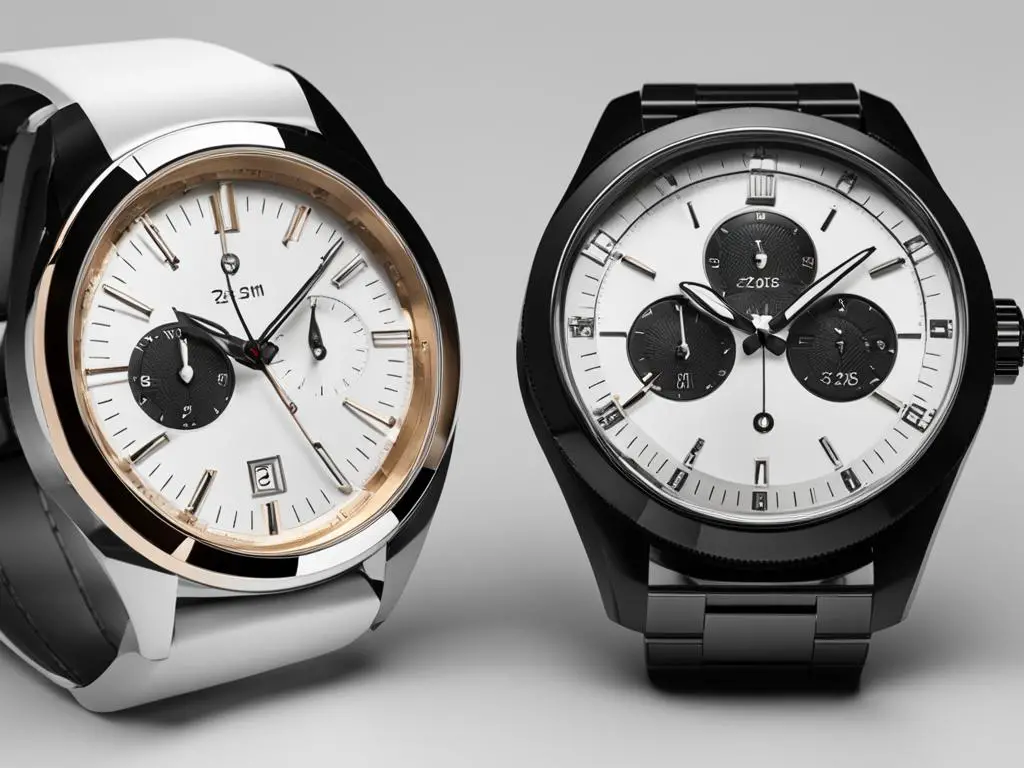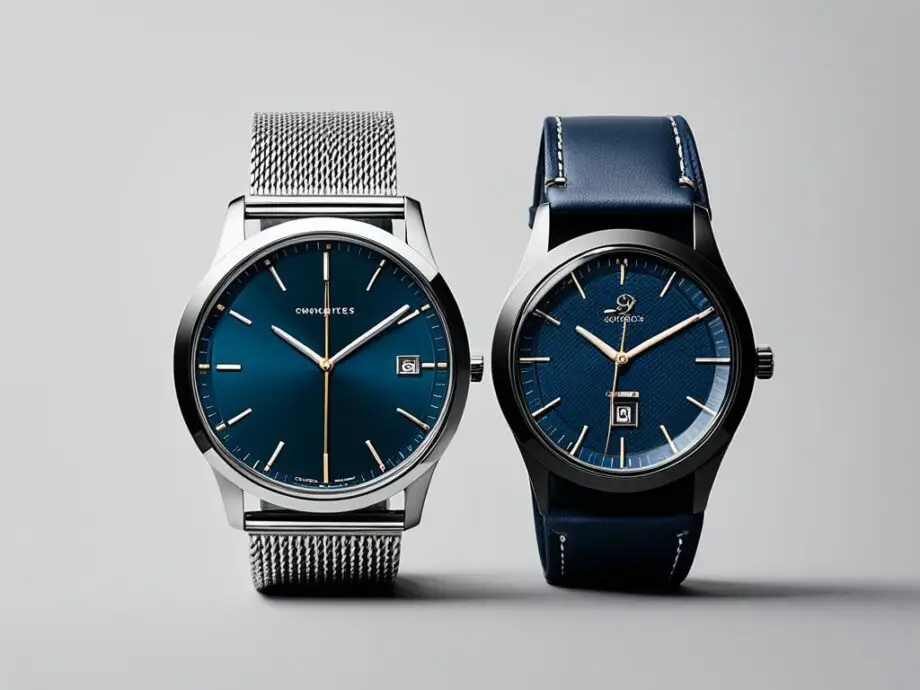Welcome to our comprehensive guide comparing the sizes of 28mm and 32mm watches. Are you in search of the perfect watch but unsure about the dimensions and how they fit on your wrist? Look no further! In this article, we will delve into the differences between these two popular watch sizes, equipping you with the knowledge to make an informed decision.
Key Takeaways
- Understanding the differences between 28mm and 32mm watches is essential when selecting a watch size.
- Consider factors such as wrist circumference, dial visibility, style choice, and potential impact on resale value.
- Personal preference plays a significant role in choosing the right watch size.
- A 28mm watch offers a smaller and more understated look, while a 32mm watch provides a slightly larger and bolder presence.
- Both watch sizes have their unique features and are suitable for different wrist sizes and preferences.
Understanding Watch Sizes: A Brief Overview
When it comes to selecting the perfect watch, size matters. Before we dive into comparing the 28mm and 32mm watches, let’s take a moment to understand watch sizes and how they are measured. This brief overview will provide you with the necessary knowledge to make an informed decision.
Common Terminology
Watch sizes are typically measured in millimeters (mm) and refer to the diameter of the watch case, excluding the crown. The crown is the small button or dial generally located on the right side of the watch, used to adjust the time. When browsing for watches, you may come across terms like “case diameter” or “watch face size,” which all refer to the same measurement.
How to Measure Your Wrist
Before selecting a watch size, it’s essential to measure your wrist to ensure a proper fit. Here are a few simple steps to measure your wrist accurately:
- Wrap a measuring tape or a piece of string around your wrist just above the bone.
- Mark where the measuring tape or string overlaps comfortably.
- Measure the length of the string or tape with a ruler.
Once you have your wrist measurement, you can refer to a watch size chart or the specific dimensions provided by the watch manufacturer to determine the appropriate size for your wrist.
Factors to Consider When Selecting a Watch Size
Choosing the right watch size goes beyond the numbers. Here are a few factors to consider:
- Wrist Circumference: A larger wrist circumference may require a larger watch size for a balanced look, while a smaller wrist may benefit from a smaller size to ensure comfort.
- Dial Visibility: A larger watch face can offer better readability, especially if you prefer a more prominent display of the hour markers, hands, or complications.
- Style Choice: Personal style and aesthetics play a significant role in selecting the right watch size. Some individuals prefer a minimalist and discreet look with a smaller watch, while others gravitate towards a statement piece with a larger and more eye-catching design.
Remember, the perfect watch size is ultimately a matter of personal preference and what feels comfortable and looks proportional on your wrist.
By understanding watch sizes, mastering wrist measurements, and considering essential factors, you’ll be well-equipped to find the ideal watch size that suits your style and wrist perfectly.

A visual representation of watch sizes can help guide you in selecting the perfect fit.
Exploring the 28mm Watch Size
When it comes to choosing the right watch, size matters. In this section, we’ll dive into the world of 28mm watches and explore their unique characteristics, suitability for different wrist sizes, and why someone might opt for this smaller size.
Characteristics of 28mm Watches
28mm watches are known for their sleek and understated designs. Their smaller size offers a refined and delicate look, making them perfect for those who prefer a subtle and elegant style. With a compact case and a more slender profile, 28mm watches exude a sense of sophistication.
Suitability for Different Wrist Sizes
The 28mm size is often associated with women’s watches due to its dainty proportions. However, it can also be a great choice for individuals with smaller wrists, regardless of gender. If you have a petite wrist or prefer a minimalist aesthetic, a 28mm watch can provide a perfect fit without overwhelming your wrist.
Why Choose a 28mm Watch?
The decision to choose a 28mm watch may depend on personal style, occasion, or desired impact. Some people prefer the subtlety and refined elegance that a smaller watch brings, while others appreciate the ease of pairing a 28mm watch with various outfits, from formal attire to casual ensembles. Additionally, a smaller watch can make a statement by showcasing attention to detail and sophistication.

The 28mm watch size offers a timeless charm and showcases an individual’s taste for refined elegance. Its delicate proportions can be a statement of understated sophistication.
Tips for Styling and Accessorizing a 28mm Watch
- Pair a 28mm watch with delicate jewelry, such as thin bracelets or dainty rings, to maintain a cohesive and elegant look.
- Opt for a classic leather strap for a timeless and versatile style, or choose a metal bracelet for a touch of modernity.
- Consider contrasting the delicate size of the watch with a bold or colorful dial to make a subtle yet impactful statement.
With its delicate proportions and refined charm, the 28mm watch size offers a unique appeal for those who appreciate understated elegance and a sense of attention to detail.
Examining the 32mm Watch Size
When it comes to choosing the right watch size, the 32mm option offers a distinct appeal. Let’s take a closer look at the unique features, compatibility with various wrist sizes, and reasons why someone might prefer this slightly larger option.
Unique Features of 32mm Watches
One of the standout features of a 32mm watch is its versatility. It strikes a balance between being eye-catching on the wrist without overpowering smaller wrists, making it suitable for a wide range of wearers. The size provides enough space for intricate dials, including additional complications such as date windows and chronographs, enhancing the overall functionality and aesthetic appeal.
Compatibility with Different Wrist Sizes
The 32mm watch size is ideal for individuals with medium-sized wrists. It offers a noticeable presence on the wrist without being too large or cumbersome. For those with smaller wrists who prefer a slightly bolder look, the 32mm watch can make a stylish statement while still maintaining a balanced proportion.
Reasons to Choose a 32mm Watch
“I love how the 32mm watch size enhances the overall elegance of my wrist. It’s not too big, not too small, and strikes the perfect balance.” – Emily, watch enthusiast
Some individuals may prefer the 32mm watch size for its subtle yet noticeable appearance. It offers a refined and sophisticated look, making it suitable for both formal occasions and everyday wear. Additionally, the versatility of this size ensures that it complements various fashion styles, from classic to contemporary.
Styling Suggestions for 32mm Watches
Pairing accessories with a 32mm watch can create a cohesive and stylish look. Consider these suggestions:
- Opt for a slim and elegant strap, such as a leather or mesh band, to enhance the sleekness of the watch.
- Choose complementary jewelry, such as delicate bracelets or minimalist rings, to create a coordinated ensemble.
- When it comes to outfit choices, the 32mm watch can effortlessly elevate both casual and formal attire. Consider wearing it with a tailored suit or a simple blouse and jeans for a touch of sophistication.
With its balanced size and elegant presence, the 32mm watch offers a timeless appeal that suits various fashion preferences and lifestyles. Whether you’re looking for a refined accessory for special occasions or an everyday companion, the 32mm watch size is a versatile and stylish choice.
Comparing 28mm and 32mm Watches
When it comes to choosing the perfect watch size, understanding the differences between 28mm and 32mm watches is essential. In this section, we’ll directly compare these two sizes, examining their similarities and differences, and helping you determine which one may be better suited for your preferences and occasions.
Similarities
- Both 28mm and 32mm watches are considered small to medium-sized.
- They are popular choices for individuals who prefer a more delicate and understated look on their wrists.
- Both sizes can be suitable for both men and women, depending on personal style and wrist size.
Differences
- The first noticeable difference between the two sizes is the overall diameter of the watch case. The 28mm watch is smaller, while the 32mm is slightly larger.
- Due to its smaller size, the 28mm watch often presents a more delicate and feminine aesthetic, perfect for those with smaller wrists or a preference for daintier timepieces.
- On the other hand, the 32mm watch offers a slightly bolder and more prominent presence on the wrist, making it a versatile choice for both casual and dressier occasions.
- The differences in size are most noticeable when examining the watch face. The 28mm watch may have a more petite dial, which can result in slightly smaller hour markers, hands, and overall visual details. The 32mm watch, being larger, has more room for these elements, making them potentially more legible and easier to read at a glance.
- It’s important to consider your wrist size when deciding between these two sizes. If you have a smaller wrist, the 28mm watch may offer a better fit and proportion, while those with larger wrists may find the 32mm watch more comfortable and visually balanced.
Ultimately, the choice between a 28mm and a 32mm watch will depend on your personal style preferences, wrist size, and the desired aesthetic you want to achieve. Consider trying on watches in both sizes to see which one feels and looks the most appealing on your wrist.

Factors to Consider When Choosing Watch Size
Choosing the right watch size goes beyond personal preference. There are several important factors to keep in mind that can help you make an informed decision. Let’s explore these factors:
1. Wrist Circumference
One of the key considerations when choosing a watch size is your wrist circumference. Measure your wrist with a flexible tape measure or a piece of string and a ruler. This measurement will guide you in selecting a size that fits comfortably.
2. Dial Visibility
The size of the watch face, or dial, can impact its visibility. If you have a smaller wrist, a watch with a larger dial may overpower your wrist and make it difficult to read the time. Conversely, a smaller dial on a larger wrist might look disproportionate. Consider the balance between the dial size and your wrist proportions to ensure optimal visibility and aesthetics.
3. Style Choice
Consider your personal style and the intended use of the watch. If you prefer a more understated, minimalist look, a smaller watch size may be a better fit. On the other hand, if you want to make a bold statement or if you have a larger wrist, a bigger watch size might suit your style better.
4. Potential Impact on Resale Value
While not always a primary concern, it’s worth noting that certain watch sizes tend to hold their value better than others in the resale market. This is influenced by factors such as current trends and demand. If the potential resale value is important to you, it can be helpful to research which watch sizes have a strong market appeal.
Remember, choosing the right watch size is a personal decision. It’s about finding a balance between comfort, visibility, style, and potential resale value. Don’t be afraid to try on different sizes and see how they look and feel on your wrist. Ultimately, the perfect watch size is the one that makes you feel confident and suits your individual taste.
| Factors to Consider | 28mm Watch | 32mm Watch |
|---|---|---|
| Wrist Circumference | A smaller watch size, suitable for narrower wrists | A slightly larger option for broader wrists |
| Dial Visibility | Can be less visible on larger wrists | Offers better visibility on larger wrists |
| Style Choice | A more understated and minimalist look | A potential statement piece |
| Potential Resale Value | May vary depending on current market trends | May vary depending on current market trends |
By considering these factors, you can navigate the choices and confidently choose the watch size that best suits your wrist and style.
Conclusion
After exploring the differences between 28mm and 32mm watches, it is clear that understanding the right watch size for your wrist is essential.
Factors such as wrist size, style preferences, and personal aesthetics play a crucial role in selecting the perfect fit. By considering these factors, you can confidently choose a watch size that not only suits your needs but also enhances your overall look.
Our comprehensive size comparison guide and recommendations provide valuable insights into the dimensions of 28mm and 32mm watches. Utilize this information to ensure you find the ideal watch dimensions that will complement your wrist and lifestyle.
